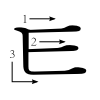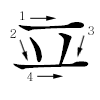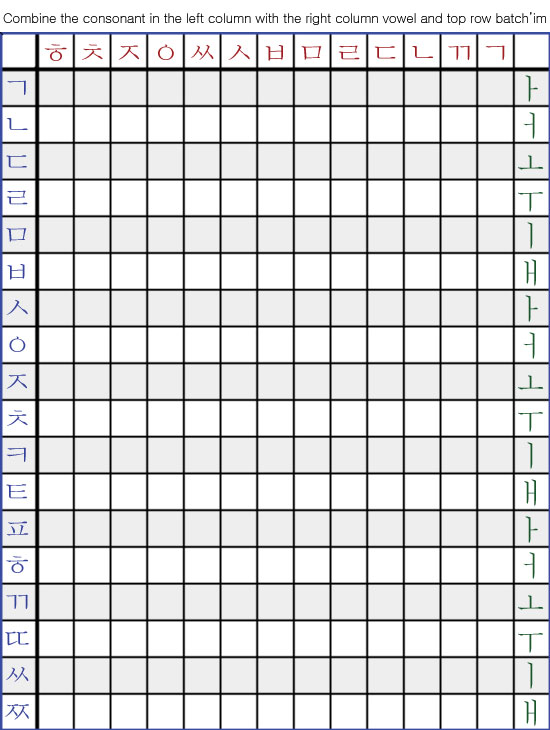Korean/Principles of Orthography
Introduction
[edit | edit source]The Korean writing system (Hangeul) has some basic principles that are easy to master.
Writing Korean letters
[edit | edit source]Consonants
[edit | edit source]When writing Korean consonants (자음, jaeum), the general rule is to start at the top left corner and work down to the bottom right. The topmost horizontal stroke is usually first, followed by any vertical strokes. The images below show the generally accepted stroke order:
For double characters, such as ㅃ and ㅉ, simply write the corresponding single character twice, close together, using the same stroke order. Once proficiency in writing has been developed, one may develop shortcuts or different forms of short-hand or cursive, for personal use. For example, ㄹ is often written similar to a backwards S as one stroke.
Vowels
[edit | edit source]With vowels (모음, moeum), the general rule is to move from left to right and top to bottom. If the character is a digraph with both horizontal and vertical components, the horizontal vowel is written first, followed by the appending vertical vowel to the right:
Syllables
[edit | edit source]In Hangeul, words are divided into blocks of characters, each block representing one syllable. For example, the word for the Korean dietary staple, kimchi, has two syllables and is thus divided into two blocks of hangul characters:
| Letter (jamo): | ㄱ | ㅣ | ㅊ | ㅣ | => | 김 | 치 | |
| ㅁ | ||||||||
| Romanization: | g i m |
ch i | 김치 (gimchi) | |||||
In modern Korean, no jamo may stand alone. Instead, they are grouped into syllables, each with an initial consonant cluster (초성), a medial vowel or diphthong (중성), and optionally a final consonant cluster (종성).
The placement or "stacking" of jamo in the block follows set patterns based on the shape of the medial.
- The components of complex jamo such as ㅄ or ㅝ are written left to right.
- Medials are written under the initial, to the right, or wrap around the initial from bottom to right, depending on their shape: If the medial has a horizontal axis like ㅡ eu, then it is written under the initial; if it has a vertical axis like ㅣ i, then it is written to the right of the initial; and if it combines both orientations, like ㅢ ui, then it wraps around the initial from the bottom to the right:
|
|
|
- A final jamo, if there is one, is always written at the bottom, under the medial:
|
|
| ||||||||||||
Blocks are always written in phonetic order, initial-medial-final. The direction of the medial (horizontal or vertical) governs the placement of the initial. These are the basic rules:
- Syllables with a horizontal medial are written downward: 읍
- Syllables with a vertical medial and simple final are written clockwise: 쌍
- Syllables with a wrapping medial switch direction (down-right-down): 된
- Syllables with a complex final are written left to right at the bottom: 밟
Initial consonant placeholder
[edit | edit source]When a syllable has no actual initial consonant, the null initial ㅇ (called 이응, ieung) is used as a placeholder. (No placeholder is needed when there is no final.)
Examples:
Horizontal medials
[edit | edit source]In a syllable with a horizontal medial (ㅛ, ㅗ, ㅡ, ㅜ, or ㅠ), the initial is written first, followed by the medial below it. With ㄱ, the vowels look like this: 교, 고, 그, 구, 규. Any other consonant behaves the same: 표, 소, 드, 부, 류. Notice how the protruding lines in each vowel nestle into any empty spaces in the consonant above it, particularly with ㄱ and ㅅ.
Vertical medials
[edit | edit source]In a syllable with a vertical medial (ㅑ, ㅏ, ㅕ, ㅓ, ㅣ, ㅐ, ㅔ, ㅒ, or ㅖ), the initial is written to the left of the vowel. With ㄱ, the vowels look like this: 갸, 가, 겨, 거, 기.
Wrapping medials
[edit | edit source]If the vowel is a wrapping medial (i.e. written with the digraphs ㅘ, ㅝ, ㅚ, ㅟ, ㅢ, ㅙ, or ㅞ), the initial is always in the top-left area, with the diphthong surrounding the consonant on the bottom and right sides. With ㄱ, the vowels look like this: 과, 궈, 괴, 귀, 긔, 괘, 궤. Notice how ㅗ fits into spaces of the consonant above it. 안녕하세요(annyeonghaseyo)/(hello)
Finals
[edit | edit source]In a syllable with a final (받침, batchim), the initial and medial are written in the top of the block, as described above, and the final is written below them. In few cases, a syllable will contain two finals. Then, the final written below is simply the two characters next to each other.
Practice
[edit | edit source]Practice 1
[edit | edit source]Combine the following jamo into Korean characters. Click "Show" to check your answers:
사 (sa), "four"
왜 (wae), "why"
몸 (mom), "body"
즐 (jeul), "enjoy"
감 (gam), "persimmon"
Practice 2
[edit | edit source]Write the following Korean words:
선 (seon), "line"
삼 (sam), "three"
관 (gwan), "pipe"
퀸 (kwin), "queen"
옮 (om), verb stem of 옮다 "to move an object"
Practice 3
[edit | edit source]Write the following Korean words:
읽 (ik), root of 읽다, "to read"
삶 (sam), "life"
닭 (dalg), "chicken"
마나마 (ma-na-ma), Manama
Practice 4
[edit | edit source]Write the following Korean words:
안남 (an-nam), Annam
암만 (am-man), Amman
나미비아 (na-mi-bi-a), Namibia
빈 (bin), Vienna
Compounds of 2
[edit | edit source]Complete this table. Or if you feel you are proficient enough, you can complete it until satisfied. Who's gonna know?
Compounds of 3
[edit | edit source]

















